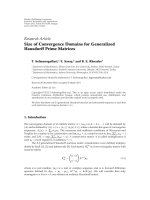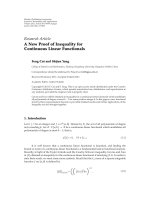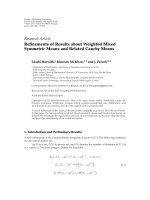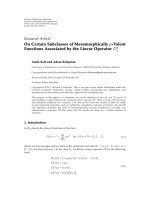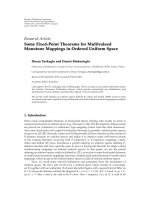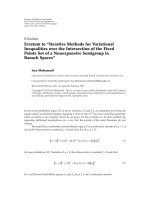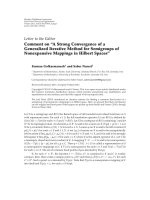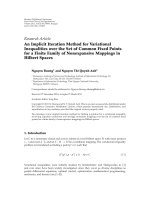Hindawi Publishing Corporation Fixed Point Theory and Applications Volume 2011, Article ID 780764, pot
Bạn đang xem bản rút gọn của tài liệu. Xem và tải ngay bản đầy đủ của tài liệu tại đây (516.02 KB, 15 trang )
Hindawi Publishing Corporation
Fixed Point Theory and Applications
Volume 2011, Article ID 780764, 15 pages
doi:10.1155/2011/780764
Research Article
An Iteration Method for Common Solution of
a System of Equilibrium Problems in Hilbert Spaces
Jong Kyu Kim
1
and Nguyen Buong
2
1
Department of Mathematics Education, Kyungnam University, Masan Kyunganm 631-701,
Republic of Korea
2
Department of Mathematics, Vietnamse Academy of Science and Technology,
Institute of Information Technology, 18, Hoang Quoc Viet, q. Cau Giay, Hanoi 122100, Vietnam
Correspondence should be addressed to Jong Kyu Kim,
Received 11 December 2010; Revised 3 March 2011; Accepted 4 March 2011
Academic Editor: Qamrul Hasan Ansari
Copyright q 2011 J. K. Kim and N. Buong. This is an open access article distributed under the
Creative Commons Attribution License, which permits unrestricted use, distribution, and
reproduction in any medium, provided the original work is properly cited.
The strong convergence theorem is proved for finding a common solution for a system of
equilibrium problems: find u
∗
∈ S : ∩
N
i1
EPF
i
, EPF
i
: {z ∈ C : F
i
z, v ≥ 0 ∀v ∈ C},i
1, ,N, where C is a closed convex subset of a Hilbert space H and F
i
are N bifunctions from
C × C into R given exactly or approximatively. As an application, finding a common solution for a
system of variational inequality problems is given.
1. Introduction
Let H be a real Hilbert space with the scalar product and the norm denoted by the symbols
·, · and ·, respectively. Let C be a nonempty closed convex subset of H,andlet
F
i
i 1, ,N be N bifunctions from C × C into R. In this paper, we consider the system of
equilibrium problems:
find u
∗
∈ S : ∩
N
i1
EP
F
i
,
EP
F
i
:
{
z ∈ C : F
i
z, v
≥ 0 ∀v ∈ C
}
,i 1, ,N.
1.1
We assume that S
/
∅ and the bifunctions F
i
satisfy the following conditions.
Condition 1. The bifunction F satisfies the following conditions:
A1 Fu, u0 for all u ∈ C.
A2 Fu, vFv, u ≤ 0 for all u, v ∈ C × C.
2 Fixed Point Theory and Applications
A3 For every u ∈ C, Fu, · : C → R is lower semicontinuous and convex.
A4
lim
t → 0
F1 − tu tz, v ≤ Fu, v for all u, z, v ∈ C × C × C.
Definition 1.1. A mapping A of C into H is called monotone if
A
x
− A
y
,x− y
≥ 0, 1.2
for all x, y ∈ C.
Now, we consider the variational inequality problem: find u
∗
∈ C such that
A
u
∗
,x− u
∗
≥ 0, 1.3
for all x ∈ C. We denote VIC, A the set of solutions of the variational inequality problem.
Definition 1.2. A mapping T of C into H is called k-strictly pseudocontractive in the
terminology of Browder and Petryshyn 1, if there exists a number k ∈ 0, 1 such that
T
x
− T
y
2
≤x − y
2
k
I − T
x
−
I − T
y
2
,
1.4
where I is the identity operator in H.
The above inequality is equivalent to
A
x
− A
y
,x− y
≥ λAx − A
y
2
,
1.5
where the operator A : I − T is λ 1 − k/2-inverse strongly monotone hence monotone
and Lipschitz continuous with the Lipschitz constant 2/1 − k. Clearly, when k 0, T is
nonexpansive, that is,
T
x
− T
y
≤x − y 1.6
for all x, y ∈ DT, the domain of T. It means that the class of k-strictly pseudocontractive
mappings strictly includes the class of nonexpansive mappings. Denote by FT the set of
fixed points of the operator T in C,thatis,
F
T
{
x ∈ C : x T
x
}
. 1.7
If N
1, then 1.1 is a single equilibrium problem 2, 3 to cover monotone inclusion
problems, saddle point problems, variational inequality problems, minimization problems,
Nash equilibria in noncooperative games, vector equilibrium problems, as well as certain
fixed point problems.
For finding approximative solutions of 1.1, there exist several approaches: the
regularization approach in 4–7, the gap-function approach in 8–10, and iterative
procedure approach in 11–15.
Fixed Point Theory and Applications 3
If N>1, then 1.1 is a problem of fi nding a common solution for a system of
equilibrium problems which is studied firstly in 5cf. 16 under the condition that
F
i
i 1, ,N are bounded, Fr
´
echet differentiable with respect to v and ∇
v
F
i
u, u are
Lipschitz continuous, that is,
∇
v
F
i
x, x
−∇
v
F
i
y, y
≤Lx − y∀x, y ∈ C, i 1, 2, ,N, 1.8
where L is a positive constant.
With the case that
F
i
u, v
I − T
i
u
,v− u
, 1.9
and T
i
i 2, ,N are N − 1 strictly pseudocontractive mappings, 1.1 is a problem of
finding a solution of an equilibrium problem which is also a common fixed point for a system
of a finite family of strictly pseudocontractive mappings 17–19.
In addition, when F
1
u, vA
1
u,v − u where A
1
is a monotone operator, 1.1
is a problem of finding an element which is a solution of a variational inequality problem
and a common fixed point for a finite family of strictly pseudocontractive mappings and
investigated intensively in 20–32.IfallF
i
have the form 1.9, then 1.1 is a problem of
finding a common fixed point for a finite family of strictly pseudocontractive mappings T
i
from C into H 14, 33–35.
In this paper, we present an iteration method for solving 1.1, where the iteration
sequence {x
n
} is defined by
x
0
x ∈ H,
u
i
n
∈ C : F
i
u
i
n
,v
u
i
n
− x
n
,v− u
i
n
≥ 0, ∀v ∈ C, i 1, ,N,
x
n1
x
n
− β
n
n
i1
x
n
− u
i
n
α
n
x
n
,
1.10
where {α
n
}, {β
n
} are two sequences of positive numbers satisfying some conditions.
As an application, we find a common solution for a system of N variational inequality
problems with monotone mappings.
2. Main Results
The strong and weak convergence of any sequence are denoted by → and , respectively.
We formulate the following facts which are necessary in the proof of our main results.
Lemma 2.1 see 5. Let C be a nonempty closed convex subset of a Hilbert space H, and let F be a
bifunction of C × C into R satisfying the Condition 1.Letr>0 and x ∈ H. Then, there exists z ∈ C
such that
F
z, v
1
r
z − x, v − z
≥ 0, ∀v ∈ C.
2.1
4 Fixed Point Theory and Applications
Lemma 2.2 see 5. Assume that F : C × C → R satisfies the Condition 1. For r>0 and x ∈ H,
define a mapping T
r
: H → C as follows:
T
r
x
z ∈ C : F
z, v
1
r
z − x, v − z
≥ 0, ∀v ∈ C
. 2.2
Then, the following hold:
i T
r
is single-valued;
ii T
r
is firmly nonexpansive, that is, for any x, y ∈ H,
T
r
x
− T
r
y
2
≤
T
r
x
− T
r
y
,x− y
;
2.3
iii FT
r
EPF;
iv EPF is closed and convex.
Lemma 2.3. Let F
h
u, v be a bifunction approximating the bifunction Fu, v in the sense
F
h
u, v
− F
u, v
≤ hg
u
u − v∀u, v ∈ C, h > 0, 2.4
where gt is a real positive function. Then, for each r>0 and x ∈ H, we have
T
h
r
x
− T
r
x
≤rhg
T
r
x
,
2.5
where
T
h
r
x
z ∈ C : F
h
z,v
1
r
z − x, v − z
≥ 0 ∀v ∈ C
. 2.6
Proof. Let x be an arbitrary element of H. By replacing v by z in 2.2 and by z in 2.6,we
obtain
F
z, z
F
h
z, z
≥
1
r
x − z, z − z
z − x, z − z
.
2.7
Therefore, by virtue of A2 in Condition 1, we can write
F
z, z
− F
h
z, z
≥
1
r
z − z
2
.
2.8
Consequently,
z − z≤rhg
T
r
x
. 2.9
The proof is completed.
Fixed Point Theory and Applications 5
Lemma 2.4 see 36. Let {a
n
}, {b
n
}, and {c
n
} be sequences of positive numbers satisfying the
conditions:
i a
n1
≤ 1 − b
n
a
n
c
n
,b
n
< 1,
ii
∞
n0
b
n
∞, lim
n → ∞
c
n
/b
n
0.
Then, lim
n → ∞
a
n
0.
Lemma 2.5 see 37. Assume that T is a nonexpansive mapping of a closed convex subset C of a
Hilbert space H.ThenI − T is demiclosed at zero; that is whenever {x
n
} is a sequence in C weakly
converging to some x ∈ C and the sequence {I − Tx
n
} strongly converges to zero, it follows
I − Tx0.
Lemma 2.6 see 17. Let A be a λ-inverse strongly monotone mapping from C into H such that
S
A
/
∅,whereS
A
{x ∈ C : Ax0}. Then, S
A
VIC, A.
Now, consider the firmly nonexpansive mappings T
i
defined by
T
i
x
{
z ∈ C : F
i
z, v
z − x, v − z
≥ 0, ∀v ∈ C
}
,i 1, ,N. 2.10
By virtue of Lemma 2.2, we can see T
i
is nonexpansive. Consequently, A
i
: I − T
i
is 1/2-
inverse strongly monotone and Lipschitz continuous with the Lipschitz constant L
i
2, i
1, ,N.
We construct a Tikhonov regularization solution y
n
for 1.1 by solving the following
operator equation: find y
n
∈ H such that
N
i1
A
i
y
n
α
n
y
n
0,
2.11
where the positive regularization parameter α
n
→ 0asn → ∞.Wehavethefollowing
result.
Theorem 2.7. i For each α
n
> 0, problem 2.11 has a unique solution y
n
.
ii lim
n → ∞
y
n
u
∗
, u
∗
∈ S, u
∗
≤y, for all y ∈ S.
iii y
n
− y
m
≤|α
n
− α
m
|/α
n
u
∗
.
Proof. i Since the mapping
n
i1
A
i
is a monotone and Lipschitz continuous mapping
defined on H, it is maximal monotone. Therefore, 2.11 has a unique solution for each α
n
> 0
38.
ii For each y ∈ S,onthebaseofLemma 2.2, we have that A
i
y0, i 1, ,N.
Thus, from 2.11 it follows that
N
i1
A
i
y
n
− A
i
y
,y
n
− y
α
n
y
n
,y
n
− y
0.
2.12
Since every A
i
is monotone, from the last equality, we obtain
y
n
,y
n
− y
≤ 0. 2.13
6 Fixed Point Theory and Applications
Hence,
y
n
≤y, ∀y ∈ S. 2.14
It means that the sequence {y
n
} is bounded. Let {y
n
k
} be a subsequence of the sequence {y
n
}
such that y
n
k
y as k →∞.
Again, let y be an arbitrary element of S.Fromthe1/2-inverse strongly monotone
property of A
l
,andA
l
y0, l 1, ,N, it implies that
1
2
y
n
k
− T
l
y
n
k
2
≤
A
l
y
n
k
,y
n
k
− y
≤
N
i1
A
i
y
n
k
,y
n
k
− y
≤−α
n
k
y
n
k
,y
n
k
− y
−α
n
k
y
n
k
− y, y
n
k
− y
− α
n
k
y, y
n
k
− y
≤−α
n
k
y, y
n
k
− y
≤ α
n
k
2y
2
,
2.15
that is,
y
n
k
− T
l
y
n
k
≤2y
α
n
k
. 2.16
Therefore,
lim
k →∞
A
l
y
n
k
0.
2.17
By Lemma 2.5, A
l
y0, that is, y ∈ FT
l
, l 1, ,N. It means that y ∈ S. Because S is
a closed convex subset in Hilbert space, it has a unique minimal element u
∗
in norm. From
2.14 and the weak convergence of {y
n
k
} to y u
∗
, it also follows that y
n
k
→u
∗
,as
k →∞. Moreover, the sequence {y
n
} converges strongly to u
∗
as n →∞.
iii From 2.11 , 2.14, and the monotone property of A
i
, it follows
α
n
y
n
,y
n
− y
m
− α
m
y
m
,y
n
− y
m
≤ 0 2.18
or
y
n
− y
m
≤
|
α
n
− α
m
|
α
n
y
m
≤
|
α
n
− α
m
|
α
n
u
∗
,
2.19
for each α
n
,α
m
> 0. The proof is completed.
Fixed Point Theory and Applications 7
Theorem 2.8. Suppose that α
n
,β
n
satisfy the following conditions:
α
n
,β
n
> 0
α
n
≤ 1
, lim
n →∞
α
n
lim
n →∞
|
α
n
− α
n1
|
α
2
n
β
n
0,
∞
n0
α
n
β
n
∞, lim
n →∞
β
n
2N α
n
2
α
n
< 1.
2.20
Then,
lim
n →∞
x
n
u
∗
∈ S,
2.21
where x
n
is defined by 1.10.
Proof. Let y
n
be a solution of 2.11.SetΔ
n
x
n
− y
n
. Then,
Δ
n1
x
n1
− y
n1
≤x
n1
− y
n
y
n1
− y
n
,
x
n1
− y
n
x
n
− y
n
− β
n
N
i0
A
i
x
n
− A
i
y
n
α
n
x
n
− y
n
.
2.22
From the monotone and Lipschitz continuous properties of A
i
, i 1, ,N, 2.11,andu
i
n
T
i
x
n
, we can write
x
n
− y
n
− β
n
N
i1
A
i
x
n
− A
i
y
n
α
n
x
n
− y
n
2
x
n
− y
n
2
β
2
n
N
i1
A
i
x
n
− A
i
y
n
α
n
x
n
− y
n
2
− 2β
n
N
i1
A
i
x
n
− A
i
y
n
α
n
x
n
− y
n
,x
n
− y
n
≤x
n
− y
n
2
1 − 2β
n
α
n
β
2
n
2N α
n
2
.
2.23
Hence,
x
n1
− y
n
≤Δ
n
1 − 2β
n
α
n
β
2
n
2N α
n
2
1/2
.
2.24
Therefore,
Δ
n1
≤ Δ
n
1 − 2β
n
α
n
β
2
n
2N α
n
2
1/2
|
α
n
− α
n1
|
α
n
u
∗
≤ Δ
n
1 − α
n
β
n
1/2
|
α
n
− α
n1
|
α
n
u
∗
.
2.25
8 Fixed Point Theory and Applications
Thus, applying the inequality
a b
2
≤
1 ε
a
2
b
2
ε
ε>0
,ε
α
n
β
n
2
, 2.26
we obtain
0 ≤ Δ
2
n1
≤ Δ
2
n
1 − α
n
β
n
1
1
2
α
n
β
n
α
n
− α
n1
α
n
u
∗
2
2
α
n
β
n
1
1
2
α
n
β
n
≤ a
2
n
1 −
1
2
α
n
β
n
−
1
2
α
n
β
n
2
α
n
− α
n1
α
2
n
β
n
u
∗
2
2α
n
β
n
1
1
2
α
n
β
n
.
2.27
Set
b
n
α
n
β
n
1
2
1
2
α
n
β
n
,
c
n
α
n
− α
n1
α
2
n
β
n
u
∗
2
2α
n
β
n
1
1
2
α
n
β
n
.
2.28
It is not difficult to check that b
n
and c
n
satisfy the conditions in Lemma 2.4 for sufficiently
large n. Hence, lim
n → ∞
Δ
2
n
0. Since lim
n →∞
y
n
u
∗
, we have
lim
n →∞
x
n
u
∗
∈ S.
2.29
Now, let F
n
i
u, v : F
h
n
i
u, v be bifunctions approximating the bifunctions F
i
u, v in
the sense 2.4 where h
n
→ 0, as n →∞,andgt is a real positive and bounded the image
of any bounded set is bounded function. Then, the sequence of iterations {x
n
} is defined by
x
0
x ∈ H,
u
i
n
∈ C : F
n
i
u
i
n
,v
u
i
n
− x
n
,v− u
i
n
≥ 0 ∀v ∈ C, i 1, ,N,
x
n1
x
n
− β
n
n
i1
x
n
− u
i
n
α
n
x
n
,
2.30
where {α
n
}, {β
n
} are two sequences of positive numbers satisfying some conditions.
We have the following result.
Theorem 2.9. Suppose that α
n
,β
n
, and h
n
satisfy the conditions in Theorem 2.8 and
lim
n →∞
h
n
h
n1
α
2
n
β
n
0.
2.31
Fixed Point Theory and Applications 9
Then, we have
lim
n →∞
x
n
u
∗
∈ S,
2.32
where x
n
is defined by 2.30.
Proof. Let y
n
be a solution of the following equation:
N
i1
A
n
i
y
n
α
n
y
n
0,A
n
i
I − T
n
i
,
2.33
where each T
n
i
is defined by
T
n
i
x
z ∈ C : F
n
i
z, v
z − x, v − z
≥ 0, ∀v ∈ C
,i 1, ,N. 2.34
Since
x
n
− u
∗
≤x
n
− y
n
y
n
− y
n
y
n
− u
∗
, 2.35
and lim
n →∞
y
n
u
∗
, in order to prove that lim
n →∞
x
n
u
∗
, it is necessary to prove that
lim
n →∞
x
n
− y
n
lim
n →∞
y
n
− y
n
0.
2.36
For this purpose, first we estimate the value y
n
− y
n
.OnthebasisofLemma 2.3, we h ave
A
i
x
− A
n
i
x
T
i
x
− T
n
i
x
≤h
n
g
T
i
x
. 2.37
Therefore, from 2.11, 2.33, and the monotone property of A
n
i
it implies that
y
n
− y
n
2
1
α
n
N
i1
A
n
i
y
n
− A
i
y
n
,y
n
− y
n
≤
1
α
n
N
i1
A
n
i
y
n
− A
i
y
n
,y
n
− y
n
.
2.38
Consequently, we have
y
n
− y
n
≤
1
α
n
N
i1
A
n
i
y
n
− A
i
y
n
≤ N
h
n
α
n
g
T
i
y
n
.
2.39
10 Fixed Point Theory and Applications
On the other hand,
T
i
y
n
T
i
y
n
− T
i
u
∗
u
∗
≤y
n
− u
∗
u
∗
≤y
n
2u
∗
≤ 3u
∗
.
2.40
Therefore,
y
n
− y
n
≤C
0
N
h
n
α
n
,
2.41
where C
0
sup{gt :0<t≤ 3u
∗
}. It means that lim
n →∞
y
n
u
∗
because lim
n →∞
h
n
/α
n
0.
Secondly, to prove
lim
n →∞
x
n
− y
n
0,
2.42
as in the proof of Theorem 2.8, first we need to estimate the value y
n1
− y
n
. By the argument
as in the proof of Theorem 2.7, we have
N
i1
A
n
i
y
n
− A
n1
i
y
n1
, y
n
− y
n1
α
n
y
n
, y
n
− y
n1
− α
n1
y
n1
, y
n
− y
n1
0.
2.43
Thus,
y
n
− y
n1
2
α
n
− α
n1
α
n
− y
n1
, y
n
− y
n1
1
α
n
N
i1
A
n1
i
y
n1
− A
n
i
y
n
, y
n
− y
n1
≤
α
n
− α
n1
α
n
− y
n
, y
n
− y
n1
1
α
n
N
i1
A
n1
i
y
n1
− A
n
i
y
n
, y
n
− y
n1
≤
α
n
− α
n1
α
n
y
n
y
n
− y
n1
1
α
n
N
i1
A
n1
i
y
n
− A
n
i
y
n
, y
n
− y
n1
.
2.44
Therefore,
y
n
− y
n1
≤
α
n
− α
n1
α
n
y
n
1
α
n
N
i1
A
n1
i
y
n
− A
i
y
n
A
i
y
n
− A
n
i
y
n
≤
α
n
− α
n1
α
n
y
n
N
h
n
h
n1
α
n
g
y
n
.
2.45
Fixed Point Theory and Applications 11
Using 2.14 and 2.41, we have
y
n
≤u
∗
C
0
N
h
n
α
n
.
2.46
Consequently, there exists a positive constant C such that y
n
≤C for n ≥ 0. Finally, we have
y
n
− y
n1
≤
α
n
− α
n1
α
n
C NC
1
h
n
h
n1
α
n
,
2.47
where C
1
sup{gt :0<t<C}.Now,set
Δ
n
x
n
− y
n
.Itisnotdifficult to verify that
x
n1
− y
n
≤
Δ
n
1 − 2β
n
α
n
β
2
n
2N α
n
2
1/2
,
Δ
n1
≤
Δ
n
1 − α
n
β
n
1/2
|
α
n
− α
n1
|
α
n
C NC
1
h
n
h
n1
α
n
.
2.48
Therefore, lim
n →∞
Δ
n
0. The proof is completed.
Remark. The sequences α
n
1 n
−p
,0<p<1/2, and β
n
γ
0
α
n
with
0 <γ
0
<
1
2N α
0
2
,
2.49
satisfy all the necessary conditions in Theorem 2.8.
3. Applications
Consider the following problem: find an element u
∗
∈ C such that
A
i
u
∗
,v− u
∗
≥ 0, ∀v ∈ C, i 1, ,N, 3.1
where A
i
are N monotone hemicontinuous mappings from a closed convex subset C of a
Hilbert space H into H.
Theorem 3.1. Let x
0
x be an arbitrary element in H.If{α
n
}, {β
n
} are chosen as in Theorem 2.8,
and the iteration sequence {x
n
} is defined as follows:
u
i
n
∈ C,
A
i
u
i
n
,v− u
i
n
u
i
n
− x
n
,v− u
i
n
≥ 0, ∀v ∈ C, i 1, ,N,
x
n1
x
n
− β
n
N
i1
x
n
− u
i
n
α
n
x
n
,
3.2
then the sequence {x
n
} converges strongly to a common solution for 3.1.
12 Fixed Point Theory and Applications
If C ≡ H, then we have a problem of finding a common zero for a system of monotone
hemicontinous mappings A
i
, i 1, ,N. In this case, variational inequality in 3.2 has the
form A
i
u
i
n
u
i
n
x
n
. Therefore, we have the following result.
Theorem 3.2. Let A
i
,i 1, ,Nbe N hemicontinuous monotone mappings defined on H.Letx
0
x be an arbitrary element in H,let{α
n
} and {β
n
} be the sequences that are chosen as in Theorem 2.8,
and, the iteration sequence {x
n
} be defined as follows:
u
i
n
: A
i
u
i
n
u
i
n
x
n
,
x
n1
x
n
− β
n
N
i1
x
n
− u
i
n
α
n
x
n
.
3.3
Then the sequence {x
n
} converges strongly to an element u
∗
such that
A
i
u
∗
0,i 1, ,N. 3.4
Without the strongly or uniformly monotone property for A
i
, each problem of 3.1,
in general, is ill-posed. Some methods for finding a solution of each variational inequality in
3.1 are presented in 39.
Here we show an iterative regularization method for finding a common solution of
these problems. Suppose that instead of A
i
, we have their monotone approximations A
n
i
such
that DA
n
i
C and
A
n
i
x
− A
i
x
≤h
n
g
x
,i 1, ,N, 3.5
where the positive parameter h
n
→ 0asn →∞,andgt is a real positive and bounded
function. Obviously, the bifunctions
F
n
u, v
:
A
n
i
u
,v− u
,i 1, ,N, 3.6
satisfy the Condition 1 and 2.4. Therefore, we have the following theorem.
Theorem 3.3. Let x
0
x be an arbitrary element in H.If{α
n
}, {β
n
} are chosen as in Theorem 2.9,
and the iteration sequence {x
n
} is defined as follows:
u
i
n
∈ C :
A
i
u
i
n
,v− u
i
n
u
i
n
− x
n
,v− u
i
n
≥ 0 ∀v ∈ C, i 1, ,N,
x
n1
x
n
− β
n
N
i1
x
n
− u
i
n
α
n
x
n
,
3.7
then the sequence { x
n
} converges strongly to a common solution for 3.1.
If C ≡ H, then a common zero for a system of monotone hemicontinuous mappings
A
i
, i 1, ,N, could be found by the following.
Fixed Point Theory and Applications 13
Theorem 3.4. Let A
i
, i 1, ,Nbe N hemicontinuous monotone mappings defined on H.Letx
0
x be an arbitrary element in H,let{α
n
} and {β
n
} be the sequences that are chosen as in Theorem 2.9,
and the iteration sequence {x
n
} be defined as follows:
u
i
n
: A
i
u
i
n
u
i
n
x
n
,
x
n1
x
n
− β
n
N
i1
x
n
− u
i
n
α
n
x
n
.
3.8
Then the sequence { x
n
} converges strongly to an element u
∗
such that
A
i
u
∗
0,i 1, ,N. 3.9
Acknowledgment
This work was supported by the Kyungnam University Research Fund, 2010.
References
1 F. E. Browder and W. V. Petryshyn, “Construction of fixed points of nonlinear mappings in Hilbert
space,” Journal of Mathematical Analysis and Applications, vol. 20, pp. 197–228, 1967.
2 E. Blum and W. Oettli, “From optimization and variational inequalities to equilibrium problems,” The
Mathematics Student, vol. 63, no. 1–4, pp. 123–145, 1994.
3 W. Oettli, “A remark on vector-valued equilibria and generalized monotonicity,” Acta Mathematica
Vietnamica, vol. 22, no. 1, pp. 213–221, 1997.
4 O. Chadli, S. Schaible, and J. C. Yao, “Regularized equilibrium problems with application to
noncoercive hemivariational inequalities,” Journal of Optimization Theory and Applications, vol. 121,
no. 3, pp. 571–596, 2004.
5 P. L. Combettes and S. A. Hirstoaga, “Equilibrium programming in Hilbert spaces,” Journal of
Nonlinear and Convex Analysis, vol. 6, no. 1, pp. 117–136, 2005.
6 J. K. Kim and Ng. Buong, “Regularization inertial proximal point algorithm for monotone
hemicontinuous mapping and inverse strongly monotone mappings in Hilbert spaces,” Journal of
Inequalities and Applications, vol. 2010, Article ID 451916, 10 pages, 2010.
7 A. S. Stukalov, “A regularized extragradient method for solving equilibrium programming problems
in a Hilbert space,” Zhurnal Vychislitel’noi Matematiki i Matematicheskoi Fiziki, vol. 45, no. 9, pp. 1538–
1554, 2005.
8 I. V. Konnov and O. V. Pinyagina, “D-gap functions for a class of equilibrium problems in Banach
spaces,” Computational Methods in Applied Mathematics, vol. 3, no. 2, pp. 274–286, 2003.
9 G. Mastroeni, “Gap functions for equilibrium problems,” Journal of Global Optimization, vol. 27, no. 4,
pp. 411–426, 2003.
10 P. N. Anh and J. K. Kim, “A new method for solving monotone generalized variational inequalities,”
Journal of Inequalities and Applications, vol. 2010, Article ID 657192, 20 pages, 2010.
11 A. S. Antipin, “Equilibrium programming: gradient-type methods,” Automation and Remote Control,
vol. 58, pp. 1337–1347, 1997.
12 M. Bounkhel and B. R. Al-Senan, “An iterative method for nonconvex equilibrium problems,” Journal
of Inequalities in Pure and Applied Mathematics, vol. 7, no. 2, article 75, pp. 1–8, 2006.
13 O. Chadli, I. V. Konnov, and J. C. Yao, “Descent methods for equilibrium problems in a Banach space,”
Computers & Mathematics with Applications, vol. 48, no. 3-4, pp. 609–616, 2004.
14 G. Marino and H K. Xu, “Weak and strong convergence theorems for strict pseudo-contractions in
Hilbert spaces,” Journal of Mathematical Analysis and Applications, vol. 329, no. 1, pp. 336–346, 2007.
15
A. Moudafi, “Second-order differential proximal methods for equilibrium problems,” Journal of
Inequalities in Pure and Applied Mathematics, vol. 4, no. 1, article 18, pp. 1–7, 2003.
14 Fixed Point Theory and Applications
16 Ng. Buong, “Regularization extragradient method for a system of equilibrium problems,” Computa-
tional Methods in Applied Mathematics, vol. 7, no. 4, pp. 285–293, 2007.
17 Ng. Buong, “Approximation methods for equilibrium problems and common solution for a finite
family of inverse strongly-monotone problems in Hilbert spaces,” Applied Mathematical Sciences, vol.
2, no. 13–16, pp. 735–746, 2008.
18 M. Sang, X. Qin, and Y. Su, “A general iterative method for equilibrium problems and fixed point
problems in Hilbert spaces,” Fixed Point Theory and Applications, vol. 2007, Article ID 95412, 9 pages,
2007.
19 S. Takahashi and W. Takahashi, “Viscosity approximation methods for equilibrium problems and
fixed point problems in Hilbert spaces,” Journal of Mathematical Analysis and Applications, vol. 331, no.
1, pp. 506–515, 2007.
20 Ng. Buong, “Iterative regularization method of zero order for Lipschitz continuous mappings and
strictly pseudocontractive mappings in Hilbert spaces,” International Mathematical Forum, vol. 2, no.
61-64, pp. 3053–3061, 2007.
21 H. Iiduka and W. Takahashi, “Strong convergence theorems for nonexpansive nonself-mappings and
inverse-strongly-monotone mappings,” Journal of Convex Analysis, vol. 11, no. 1, pp. 69–79, 2004.
22 H. Iiduka and W. Takahashi, “Strong convergence theorems for nonexpansive mappings and inverse-
strongly monotone mappings,” Nonlinear Analysis: Theory, Methods & Applications, vol. 61, no. 3, pp.
341–350, 2005.
23 N. Nadezhkina and W. Takahashi, “Strong convergence theorem by a hybrid method for nonexpan-
sive mappings and Lipschitz-continuous monotone mappings,” SIAM Journal on Optimization, vol. 16,
no. 4, pp. 1230–1241, 2006.
24 M. A. Noor, Y. Yao, R. Chen, and Y C. Liou, “An iterative method for fixed point problems and
variational inequality problems,” Mathematical Communications, vol. 12, no. 1, pp. 121–132, 2007.
25 M. A. Noor and Z. Huang, “Three-step methods for nonexpansive mappings and variational
inequalities,” Applied Mathematics and Computation, vol. 187, no. 2, pp. 680–685, 2007.
26 W. Takahashi and M. Toyoda, “Weak convergence theorems for nonexpansive mappings and
monotone mappings,” Journal of Optimization Theory and Applications, vol. 118, no. 2, pp. 417–428,
2003.
27 J. K. Kim, S. Y. Cho, and X. Qin, “Hybrid projection algorithms for generalized equilibrium problems
and strictly pseudocontractive mappings,” Journal of Inequalities and Applications, vol. 2010, Article ID
312602, 18 pages, 2010.
28 J. K. Kim and K. S. Kim, “New systems of generalized mixed variational inequalities with nonlinear
mappings in Hilbert spaces,” Journal of Computational Analysis and Applications, vol. 12, no. 3, pp. 601–
612, 2010.
29 J. K. Kim and K. S. Kim, “A new system of generalized nonlinear mixed quasivariational inequalities
and iterative algorithms in Hilbert spaces,” Journal of the Korean Mathematical Society,vol.44,no.4,pp.
823–834, 2007.
30 J. K. Kim and H. G. Li, “A hybrid proximal point algorithm and stability for set-valued mixed
variational inclusions involving A, n-accretive mappings,” East Asian Mathematical Journal, vol. 26,
pp. 703–714, 2010.
31 Y. Yao, Y C. Liou, and J C. Yao, “An extragradient method for fixed point problems and variational
inequality problems,” Journal of Inequalities and Applications, vol. 2007, Article ID 38752, 12 pages, 2007.
32 L C. Zeng and J C. Yao, “Strong convergence theorem by an extragradient method for fixed point
problems and variational inequality problems,” Taiwanese Journal of Mathematics,vol.10,no.5,pp.
1293–1303, 2006.
33 Ng. Buong and Ph. van Son, “Regularization extragradient method for common fixed point of a finite
family of strictly pseudocontractive mappings in Hilbert spaces,” International Journal of Mathematical
Analysis, vol. 1, no. 25–28, pp. 1217–1226, 2007.
34 G. Wang, J. Peng, and H W. J. Lee, “Implicit iteration process with mean errors for common fixed
points of a finite family of strictly pseudocontrative maps,” International Journal of Mathematical
Analysis, vol. 1, no. 1–4, pp. 89–99, 2007.
35 L C. Zeng and J C. Yao, “Implicit iteration scheme with perturbed mapping for common fixed points
of a finite family of nonexpansive mappings,” Nonlinear Analysis: Theory, Methods & Applications, vol.
64, no. 11, pp. 2507–2515, 2006.
36 V. V. Vasi n an d A. L. A ge ev, Incorrect Problems with Priori Information, Nauka, Ekaterenburg, Russia,
1993.
Fixed Point Theory and Applications 15
37 G. Li and J. K. Kim, “Demiclosedness principle and asymptotic behavior for nonexpansive mappings
in metric spaces,” Applied Mathematics Letters, vol. 14, no. 5, pp. 645–649, 2001.
38 H. Br
´
ezis, Op
´
erateurs Maximaux Monotones et Semi-Groupes de Contractions dans les Espaces de Hilbert,
North-Holland, Amsterdam, The Netherlands, 1973.
39 Ya. Alber and Ir. Ryazantseva, Nonlinear Ill-Posed Problems of Monotone Type, Springer, Dordrecht, The
Netherlands, 2006.
